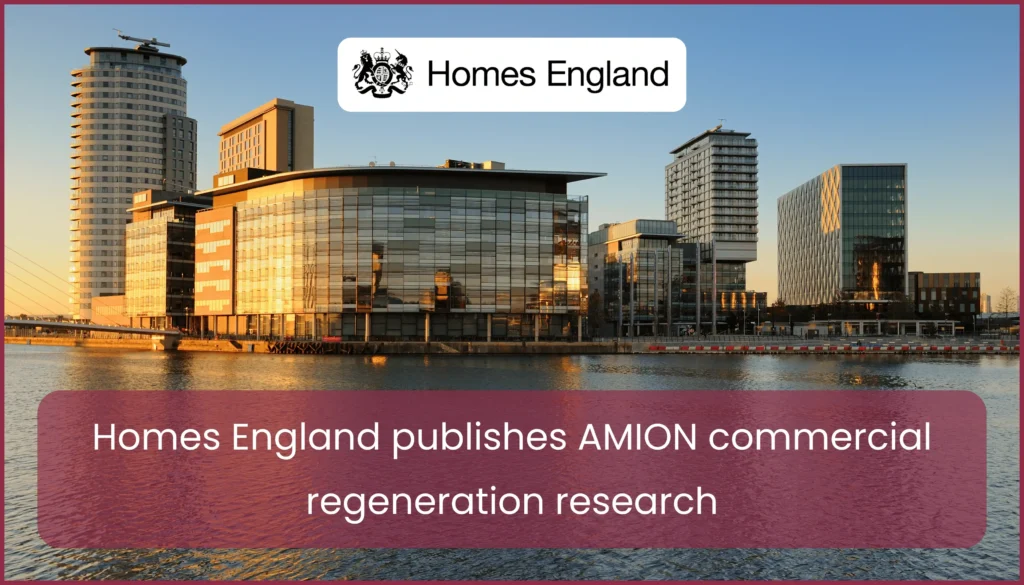We’re pleased to share new national research for Homes England on the placemaking impacts of commercial-led regeneration. The study builds on earlier Homes England work on housing-led regeneration and feeds into the 2025 Ministry of Housing, Communities and Local Government (MHCLG) Appraisal Guide. It focuses on what commercial development means for local places, rental values and regeneration outcomes.
What the research set out to do
The study had two aims: first, to test whether public sector supported commercial-led development and public realm schemes with clear placemaking objectives influence nearby commercial rents over and above local trends; second, to draw out what this means for regeneration policy and economic appraisal. We used a hedonic pricing approach based on achieved rents from the CoStar database, comparing distance-based ‘rings’ around each scheme with an outer control area. This allowed us to capture positive spillovers and any local displacement where new supply might depress surrounding rents.
A carefully selected set of case studies
From a longlist of more than 100 schemes, we shortlisted 24 and, following data checks, modelled 11 in detail. These include major city centre projects and public realm interventions, such as MediaCity in Salford, Golden Square in Birmingham’s Jewellery Quarter, Bristol Temple Meads, Spinningfields in Manchester, and Liverpool One. In total, we ran 396 models across different ring sizes to test robustness.
Headline findings
- Most schemes showed no consistent spillover effect on nearby commercial rents. In 55% of cases there was no clear external price impact.
- Where spillovers were apparent, they were highly localised. Effects typically extended to 400 metres and at most to 800 metres, which is more limited than for housing-led schemes.
- Negative rent effects, where consistent, were usually 15% to 30% below the control area. Positive effects ranged from 10% to 25%.
- In over 73% of cases there was no consistent net negative local impact. This suggests relatively low levels of local property market displacement for the case studies assessed.
Two schemes showed consistent positive spillovers with no offsetting negatives: MediaCity in Salford and Golden Square in Birmingham. MediaCity demonstrated rental uplifts of around 10% to 15% within 400 metres. Golden Square showed 8% to 16% rental gains, with signals that retail activity may be the main driver.
Bristol Temple Meads displayed both patterns: positive spillovers of 12% to 26% up to 600 metres, alongside negative effects of 7% to 16% between 600 and 800 metres. This points to rebalancing within the commercial market as demand concentrates nearer the scheme.
Two office-led schemes – Brindley Place in Birmingham and Spinningfields in Manchester – showed consistent negative spillovers, again over short distances. Six schemes, including Paradise (Birmingham), Snow Hill (Birmingham), Liverpool One, St Paul’s Square (Liverpool) and Newcastle Helix, showed no consistent overall spillovers, although some office or retail sub-sector models indicated partial effects.
Why this matters for policy and appraisal
Homes England’s mission is to support high-quality homes and thriving places, allocating public funds where they deliver the greatest social value. While commercial property is harder to analyse than housing due to data constraints, this research provides new evidence on additionality and local market effects:
- Positive spillovers can and do occur, especially where placemaking is clear and coherent.
- Where negative rent effects are present, they are usually localised and not universal across schemes.
- The overall picture points to relatively low levels of local displacement in most cases assessed.
This matters for Green Book business cases and local growth strategies. Evidence of uplift can strengthen the case for targeted public realm and commercial investment. Evidence of localised negatives can inform mitigation, for example phasing, tenant mix, or complementary transport and public realm measures.
Next steps
Further work would help test cross-market effects, such as how commercial-led regeneration influences nearby house prices, and vice versa. More case studies over longer post-completion periods would also deepen the evidence base, particularly outside major urban centres.
🔗 Read the full report: Measuring Social Value Paper 8: Measuring the Placemaking Impacts of Commercial-led Regeneration – GOV.UK

